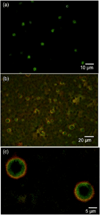Microfluidic manufacture of rt-PA -loaded echogenic liposomes
- PMID: 27206512
- PMCID: PMC4920071
- DOI: 10.1007/s10544-016-0072-0
Microfluidic manufacture of rt-PA -loaded echogenic liposomes
Abstract
Echogenic liposomes (ELIP), loaded with recombinant tissue-type plasminogen activator (rt-PA) and microbubbles that act as cavitation nuclei, are under development for ultrasound-mediated thrombolysis. Conventional manufacturing techniques produce a polydisperse rt-PA-loaded ELIP population with only a small percentage of particles containing microbubbles. Further, a polydisperse population of rt-PA-loaded ELIP has a broadband frequency response with complex bubble dynamics when exposed to pulsed ultrasound. In this work, a microfluidic flow-focusing device was used to generate monodisperse rt-PA-loaded ELIP (μtELIP) loaded with a perfluorocarbon gas. The rt-PA associated with the μtELIP was encapsulated within the lipid shell as well as intercalated within the lipid shell. The μtELIP had a mean diameter of 5 μm, a resonance frequency of 2.2 MHz, and were found to be stable for at least 30 min in 0.5 % bovine serum albumin. Additionally, 35 % of μtELIP particles were estimated to contain microbubbles, an order of magnitude higher than that reported previously for batch-produced rt-PA-loaded ELIP. These findings emphasize the advantages offered by microfluidic techniques for improving the encapsulation efficiency of both rt-PA and perflurocarbon microbubbles within echogenic liposomes.
Keywords: Echogenic liposomes; Microfluidic flow-focusing; Recombinant tissue-type plasminogen activator; Stroke treatment; Ultrasound-mediated thrombolysis.
Figures








Similar articles
-
Ultrasound-triggered release of recombinant tissue-type plasminogen activator from echogenic liposomes.Ultrasound Med Biol. 2010 Jan;36(1):145-57. doi: 10.1016/j.ultrasmedbio.2009.08.009. Ultrasound Med Biol. 2010. PMID: 19900755 Free PMC article.
-
Thrombolytic efficacy and enzymatic activity of rt-PA-loaded echogenic liposomes.J Thromb Thrombolysis. 2015 Aug;40(2):144-55. doi: 10.1007/s11239-015-1204-8. J Thromb Thrombolysis. 2015. PMID: 25829338 Free PMC article.
-
In vitro thrombolytic efficacy of echogenic liposomes loaded with tissue plasminogen activator and octafluoropropane gas.Phys Med Biol. 2017 Jan 21;62(2):517-538. doi: 10.1088/1361-6560/62/2/517. Epub 2016 Dec 21. Phys Med Biol. 2017. PMID: 28002053 Free PMC article.
-
A novel technology: microfluidic devices for microbubble ultrasound contrast agent generation.Med Biol Eng Comput. 2016 Sep;54(9):1317-30. doi: 10.1007/s11517-016-1475-z. Epub 2016 Mar 25. Med Biol Eng Comput. 2016. PMID: 27016369 Review.
-
Effective gene delivery with novel liposomal bubbles and ultrasonic destruction technology.Int J Pharm. 2008 Apr 16;354(1-2):49-55. doi: 10.1016/j.ijpharm.2007.10.034. Epub 2007 Nov 1. Int J Pharm. 2008. PMID: 18082343 Review.
Cited by
-
Overview of Therapeutic Ultrasound Applications and Safety Considerations: 2024 Update.J Ultrasound Med. 2025 Mar;44(3):381-433. doi: 10.1002/jum.16611. Epub 2024 Nov 11. J Ultrasound Med. 2025. PMID: 39526313 Free PMC article. Review.
-
Nanomaterials as Ultrasound Theragnostic Tools for Heart Disease Treatment/Diagnosis.Int J Mol Sci. 2022 Jan 31;23(3):1683. doi: 10.3390/ijms23031683. Int J Mol Sci. 2022. PMID: 35163604 Free PMC article. Review.
-
Targeted Delivery of Plasminogen Activators for Thrombolytic Therapy: An Integrative Evaluation.Molecules. 2019 Sep 19;24(18):3407. doi: 10.3390/molecules24183407. Molecules. 2019. PMID: 31546842 Free PMC article. Review.
-
Targeted nano-delivery strategies for facilitating thrombolysis treatment in ischemic stroke.Drug Deliv. 2021 Dec;28(1):357-371. doi: 10.1080/10717544.2021.1879315. Drug Deliv. 2021. PMID: 33517820 Free PMC article.
-
Overview of Venous Thromboembolism and Emerging Therapeutic Technologies Based on Nanocarriers-Mediated Drug Delivery Systems.Molecules. 2024 Oct 15;29(20):4883. doi: 10.3390/molecules29204883. Molecules. 2024. PMID: 39459251 Free PMC article. Review.
References
-
- Akers MJ, Defelippis MR. In: Pharmaceutical Formulation Development of Peptides and Proteins. Frokjaer S, Hovgaard L, editors. Philadelphia: Taylor and Francis; 2000. pp. 145–177.
-
- Alexandrov AV, Grotta JC. Neurology. 2002;59(6):862–867. - PubMed
-
- Alexandrov AV, Wojner AW, Grotta JC. J. Neuroimaging. 2004;14(2):108–112. - PubMed
Publication types
MeSH terms
Substances
Grants and funding
LinkOut - more resources
Full Text Sources
Other Literature Sources

